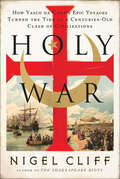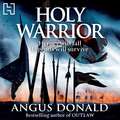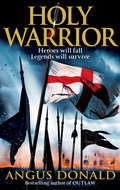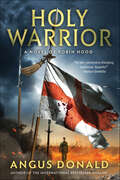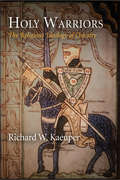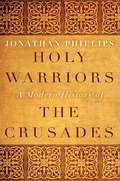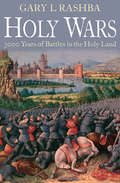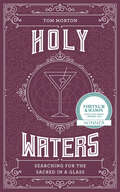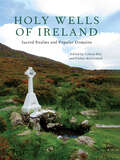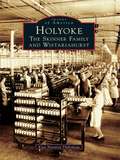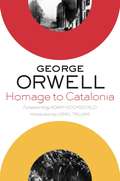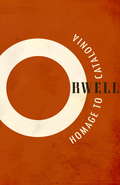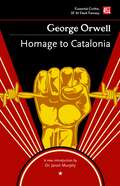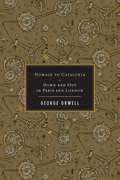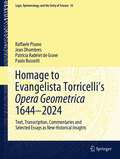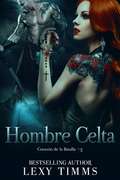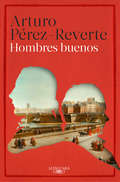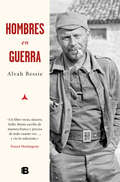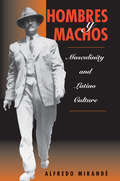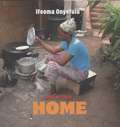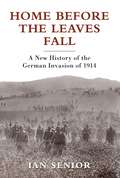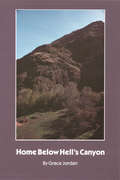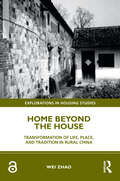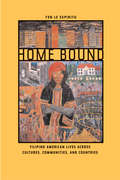- Table View
- List View
Holy War: How Vasco da Gama's Epic Voyages Turned the Tide in a Centuries-Old Clash of Civilizations
by Nigel CliffA radical reinterpretation of da Gama’s pioneering voyages, revealing their role as a decisive turning point in the struggle between Christianity & Islam.In 1498 a young captain sailed from Portugal, circumnavigated Africa, crossed the Indian Ocean, and discovered the sea route to the Indies and, with it, access to the fabled wealth of the East. It was the longest voyage known in history. The little ships were pushed beyond their limits, and their crews were racked by storms and devastated by disease. However, their greatest enemy was neither nature nor even the sheer dread of venturing into unknown worlds that existed on maps populated by coiled, toothy sea monsters. With bloodred Crusader crosses emblazoned on their sails, the explorers arrived in the heart of the Muslim East at a time when the old hostilities between Christianity and Islam had risen to a new level of intensity. In two voyages that spanned six years, Vasco da Gama would fight a running sea battle that would ultimately change the fate of three continents.An epic tale of spies, intrigue, and treachery; of bravado, brinkmanship, and confused and often comical collisions between cultures encountering one another for the first time; Holy War also offers a surprising new interpretation of the broad sweep of history. Identifying Vasco da Gama’s arrival in the East as a turning point in the centuries-old struggle between Islam and Christianity—one that continues to shape our world—Holy War reveals the unexpected truth that both Vasco da Gama and his archrival, Christopher Columbus, set sail with the clear purpose of launching a Crusade whose objective was to reach the Indies; seize control of its markets in spices, silks, and precious gems from Muslim traders; and claim for Portugal or Spain, respectively, all the territories they discovered. Vasco da Gama triumphed in his mission and drew a dividing line between the Muslim and Christian eras of history—what we in the West call the medieval and the modern ages. Now that the world is once again tipping back East, Holy War offers a key to understanding age-old religious and cultural rivalries resurgent today.
Holy Warrior (Outlaw Chronicles #2)
by Angus DonaldArrows will fly. Swords will swing. Heroes will fall. Legends will survive. And the Holy Land will never be the same.1190 AD: Richard the Lionheart has launched his epic crusade to seize Jerusalem from the cruel Saracens. Marching with the vast royal army is Britain's most famous, most feared, most ferocious warrior: the Outlaw of Nottingham, the Earl of Locksley -- Robin Hood himself.With his band of loyal men at his side, Robin cuts a bloody swathe on the brutal journey east. Daring and dangerous, he can outwit and outlast any foe -- but the crimson battlefields of the Holy Land are the ultimate proving ground. And within Robin's camp lurks a traitor -- a stealthy enemy determined to slay Christendom's greatest outlaw before the trumpets fade.Blazingly paced and richly imagined, featuring a cast of unforgettable characters and packed with fast, furious action, Holy Warrior is adventure at its thrilling, white-knuckle best.
Holy Warrior: A Novel Of Robin Hood (Outlaw Chronicles #2)
by Angus DonaldKing Richard the Lionheart has been crowned, and his loyal subject Robin Hood is preparing an army to take on the Third Crusade with Richard's forces to free the Holy Land from the grip of Saladin and his victorious Saracen army.In Sicily, en route to the Holy Land, the crusaders sack the town of Messina and Alan rescues and then falls in love with a beautiful Muslim slave-girl. But someone is trying to assassinate Robin - possibly the duo's old enemy Sir Richard Malbisse, who joins King Richard's army in Sicily and very soon has the royal ear as a favoured courtier.As Alan and Robin fight their way through the conquest of Cyprus, the siege of Acre and the climatic carnage of the battle of Arsuf near modern-day Tel Aviv, Alan discovers that Robin's motive for coming to the Holy Land is not as honourable as he had imagined...
Holy Warrior: A Novel of Robin Hood (The Outlaw Chronicles #2)
by Angus DonaldRobin Hood and his sidekick, Alan Dale, battle Saracens in the Crusades and treachery in his camp in this historical adventure by the author of Outlaw.In 1190 A.D. Richard the Lionheart, the new King of England, has launched his epic crusade to seize Jerusalem from the Saracens. Marching with the vast royal army is Britain’s most famous, feared, and ferocious warrior: the Outlaw of Nottingham, the Earl of Locksley—Robin Hood himself. With his band of loyal men at his side, Robin cuts a bloody swath on the brutal journey east. Daring and dangerous, he can outwit and outlast any foe, but the battlefields of the Holy Land are the ultimate proving ground. And within Robin’s camp lurks a traitor—a hidden enemy determined to assassinate England’s most dangerous rogue.Richly imagined and furiously paced, featuring a cast of unforgettable characters, Holy Warrior is adventure, history, and legend at its finest.
Holy Warriors
by Richard W. KaeuperThe medieval code of chivalry demanded that warrior elites demonstrate fierce courage in battle, display prowess with weaponry, and avenge any strike against their honor. They were also required to be devout Christians. How, then, could knights pledge fealty to the Prince of Peace, who enjoined the faithful to turn the other cheek rather than seek vengeance and who taught that the meek, rather than glorious fighters in tournaments, shall inherit the earth? By what logic and language was knighthood valorized?In Holy Warriors, Richard Kaeuper argues that while some clerics sanctified violence in defense of the Holy Church, others were sorely troubled by chivalric practices in everyday life. As elite laity, knights had theological ideas of their own. Soundly pious yet independent, knights proclaimed the validity of their bloody profession by selectively appropriating religious ideals. Their ideology emphasized meritorious suffering on campaign and in battle even as their violence enriched them and established their dominance. In a world of divinely ordained social orders, theirs was blessed, though many sensitive souls worried about the ultimate price of rapine and destruction.Kaeuper examines how these paradoxical chivalric ideals were spread in a vast corpus of literature from exempla and chansons de geste to romance. Through these works, both clerics and lay military elites claimed God's blessing for knighthood while avoiding the contradictions inherent in their fusion of chivalry with a religion that looked back to the Sermon on the Mount for its ethical foundation.
Holy Warriors: A Modern History of the Crusades
by Jonathan PhillipsWhen George Bush inaugurated the War on Terror in 2001, he referred to it as a 'crusade'. A medieval Crusade could be defined thus: a holy war initiated by the Pope on God's behalf in which the participants took the cross and received remission for their sins. The First Crusade, launched in 1095, ushered in a period of almost 200 years of Christian rule in the Levant, yet over time crusades were directed against a variety of opponents, not just Muslims in the Middle East: against Cathar heretics, political enemies of the papacy, the Mongols, pagan tribes of northern Europe, and the Ottoman Turks, well into the sixteenth century. While the notion of fighting for one's faith fell into disrepute during the Enlightenment, whose proponents viewed the idea as primitive and barbaric, in reality the cultural engines of romanticism and orientalism gave the memory of the crusades a significant boost in the nineteenth century. The notion of moral right buttressed by royal authority helped to drive the expansion of European power through imperialism and colonialism, and in both World Wars the theme of crusading was used as a call to arms. As Jonathan Philips demonstrates in this timely and revealing study, crusading has proven to be a remarkably adaptable and long-lasting phenomenon, embedded in the actions and consciousness of the West for centuries. Unlike other histories of the Crusades this one firstly comes up to the present day and secondly, avoids a chronological slog through the whole movement. Instead it drills a series of bore holes into the key aspects and moments: The First Crusade, Richard the Lionheart and Saladin, the Templars, the Jihad, etc. Thirdly, it is incredibly vivid and accessible - we hear the swords, taste the food, see the sights and feel the heat.
Holy Wars: 3000 Years of Battles in the Holy Land
by Gary L. Rashba&“A compelling tale of how this spiritually and politically charged area of the globe has long been a place of pivotal battles&” (Library Journal). Today&’s Arab-Israeli conflict is merely the latest iteration of an unending history of violence in the Holy Land—a region that is unsurpassed as witness to a kaleidoscopic military history involving forces from across the world and throughout the millennia. Holy Wars describes three thousand years of war in the Holy Land with the unique approach of focusing on pivotal battles or campaigns, beginning with the Israelites&’ capture of Jericho and ending with Israel&’s last full-fledged assault against Lebanon. Its chapters stop along the way to examine key battles fought by the Philistines, Assyrians, Greeks, Romans, Arabs, Crusaders, and Mamluks—the latter clash, at Ayn Jalut, comprising the first time the Mongols suffered a decisive defeat. The modern era saw the rise of the Ottomans and an incursion by Napoleon, who only found bloody stalemate outside the walls of Akko. The Holy Land became a battlefield again in World War I when the British fought the Turks. The nation of Israel was forged in conflict during its 1948 War of Independence, and subsequently found itself in desperate combat, often against great odds, in 1956 and 1967, and again in 1973, when it was surprised by a massive two-pronged assault. By focusing on the climax of each conflict, while carefully setting each stage, Holy Wars examines an extraordinary breadth of military history—spanning in one volume the evolution of warfare over the centuries, as well as the enduring status of the Holy Land as a battleground.
Holy Waters: Searching for the sacred in a glass
by Tom MortonTom Morton, keen motorcyclist, funeral celebrant and whisky aficionado, takes us on a journey around the globe, exploring the links between famous alcoholic spirits and spirituality.Waters of life. Distilled spirits of all kinds have borne that name, in various tongues, since time immemorial. Aqua vita. Eau de vie. Uisge Beatha.Tom Morton has travelled the world in search of the finest drams the planet has to offer. His journeys reveal the links between faith and alcohol, between spirits and the spiritual. From Christianity&’s Holy Communion to the temple libations of Japan, through the rum concoctions of Haitian Voodoo to the monastic producers of every liquid from beer to "tonic" wine. And of course Tom&’s beloved whisky, brewed in many corners of the world.Holy Waters is Tom&’s journey to the spiritual heart of whisky, sake, rum, Champagne, beer, mead and a variety of wines. With great insight, humour and for the most part sobriety, he traces the links between brewing, winemaking, distilling and worship, from ancient pagan rites to the most modern Trappist technology. He revels in the lore and mysteries of craft production, the elemental, magical love stories, the passionate relationships between human and landscape, grain and pure water, grape and fire. And he does so on a motorcycle which, to his astonishment, runs very well on cask-strength Islay single malt. This book is a celebration of cultures and artisan craft, a book for food and drink, travel and history lovers.
Holy Wells of Ireland: Sacred Realms and Popular Domains (Irish Culture, Memory, Place)
by Ray Cashman Celeste Ray Ronan Foley Bruce Misstear Gary Branigan Michael Gibbons Amanda Clarke Claire Collins Eileen Murphy Carol Barron Eugene Broderick Attracta Brownlee Janet Cassidy Hannah Chew Anne Cormican Christy Cunniffe Colm Donnelly Maura Egan Noel French Laurence Gill Annie Griffith Michael Houlihan Ryan Lash Shane Lehane Shane Lordan Geraldine Lynch Niall Mac Coitir John Makem Bernadette Masterson Patrick McAteer Rita McCarthy Finbar McCormick Tamlyn McHugh Cora McKenna Edward N. Moran Stiofán Ó Cadhla Suzanne Pegley Gerry A. Quinn Anja Renkes Fred TernanThe storied landscapes of Ireland are dotted with holy wells—hallowed springs, pools, ponds, and lakes credited with curative powers and often associated with Catholic and indigenous saints. While many of these sites have been recently lost to development, others are visited daily for devotions and remain the focus of annual community gatherings.Encouraging both their use and protection, Holy Wells of Ireland delves into these irreplaceable resources of spiritual, archaeological, and historical significance. Reserves of localized spiritual practices, holy wells are also ecosystems in themselves and provide habitats for rare and culturally meaningful flora and fauna. The shift toward a "post-Catholic" Ireland has prompted renewed interest in holy wells as popular domains with organic faith traditions. Of the roughly 3,000 holy wells documented across Ireland, some attract international pilgrims and others are stewarded by a single family. Featuring 140 color images, this remarkable volume shares the transdisciplinary work of contributors who study these wells through the overlapping lenses of anthropology, archaeology, art history, biomedicine, folklore, geography, history, and hydrology. Braiding community perspectives with those of scholars across academia, Holy Wells of Ireland considers Irish holy wells as a resilient feature of ever-evolving Irish Christianity, as inspiration to other faith traditions, as places of pilgrimage and healing, and as threatened biocultural resources.
Holyoke: The Skinner Family and Wistariahurst
by Kate Navarra ThibodeauBorn in England in 1824, William Skinner was a tradesman who, at 19, immigrated to the United States. Skinner turned his skill and resourcefulness into a tremendous success. He first went to work in Northampton and eventually opened the Unquomonk Silk Mills in nearby Haydenville. Skinner would have remained there had a flood not destroyed his business. He built a new mill along the canals in Holyoke, one of America's first planned industrial cities, and moved his family home, Wistariahurst, to the city by dismantling it piece by piece. Residing in Holyoke for eight decades, the Skinner family contributed greatly to the community. Holyoke: The Skinner Family and Wistariahurst contains a rich legacy of photographs, letters, journals, and oral histories that provide an amazing view into life at Wistariahurst and the adventures of the family and their servants.
Homage to Catalonia
by George Orwell Adam Hochschild Lionel TrillingA National Review Top Ten Best Nonfiction Books of the Century "One of Orwell's very best books and perhaps the best book that exists on the Spanish Civil War."--The New Yorker In 1936, originally intending merely to report on the Spanish Civil War as a journalist, George Orwell found himself embroiled as a participant--as a member of the Workers' Party of Marxist Unity. Fighting against the Fascists, he described in painfully vivid and occasionally comic detail life in the trenches--with a "democratic army" composed of men with no ranks, no titles, and often no weapons--and his near fatal wounding. As the politics became tangled, Orwell was pulled into a heartbreaking conflict between his own personal ideals and the complicated realities of political power struggles. Considered one of the finest works by a man V. S. Pritchett called "the wintry conscience of a generation," Homage to Catalonia is both Orwell's memoir of his experiences at the front and his tribute to those who died in what he called a fight for common decency. This edition features a new foreword by Adam Hochschild placing the war in greater context and discussing the evolution of Orwell's views on the Spanish Civil War. "No one except George Orwell . . . made the violence and self-dramatization of Spain so burning and terrible."-- Alfred Kazin, New York Times "A wise book, one that once read will never be forgotten."--Chicago Sunday Tribune
Homage to Catalonia
by George OrwellA first-hand account of the horrors of the Spanish Civil War, straight from the pen of one of the twentieth century's most renowned authors.<P> In 1936, George Orwell enlisted with a left-wing Spanish militia organization, The Workers' Part of Marxist Unification, out of a combined desire to fight against fascism and to record the events of the war. He fought against the fascist forces for several months, before infighting among the various left-wing groups turned him against former allies, and eventually forced him to flee the country. Homage to Catalonia is a vivid, intensely personal retelling of these events. Penguin Random House Canada is proud to bring you classic works of literature in e-book form, with the highest quality production values. Find more today and rediscover books you never knew you loved.
Homage to Catalonia (Essential Gothic, SF & Dark Fantasy)
by George OrwellA new edition of Orwell's early work, showing the origins of his commitment to social justice.A new edition with a new introduction, this is a deeply personal record of Orwell's growing despair and disillusionment with the Spanish Civil War, gathering themes he would later explore to perfection in Animal Farm and Nineteen Eighty-Four. Having joined the international leftist forces in Barcelona, Orwell grew frustrated by the repressive totalitarianism of Stalin's brand of communism.
Homage to Catalonia / Down and Out in Paris and London
by George OrwellHomage to Catalonia is both a memoir of Orwell's experience at the front in the Spanish Civil War and a tribute to those who died in what he called a fight for common decency. Down and Out in Paris and London chronicles the adventures of a penniless British writer who finds himself rapidly descending into the seedy heart of two great European cities. This edition brings together two powerful works from one of the finest writers of the twentieth century.
Homage to Evangelista Torricelli’s Opera Geometrica 1644–2024: Text, Transcription, Commentaries and Selected Essays as New Historical Insights (Logic, Epistemology, and the Unity of Science #55)
by Jean Dhombres Paolo Bussotti Raffaele Pisano Patricia Radelet de GraveEvangelista Torricelli exemplifies the use the moderns made of the ancients' mathematical methods. Celebrating Evangelista Torricelli's monumental Opera geometrica, this book marks 380 years since its publication (1644-2024). This homage to Torricelli introduces the magnificent major work in Mechanics and Mathematics of a brilliant Archimedean–and–Galilean scientist to modern readers.Opera geometrica deals with Motion & Mechanics and Geometry & Infinitesimals. In quibus Archimedis doctrina Torricelli also presents his mechanical principle of equilibrium – the foundation of the modern Principle of Virtual Work/Static.This outstanding source and research book spotlights the relevance and originality of Torricelli’s Mechanics, and is the first and most profound analysis of the Opera geometrica to date. The historical study is achieved in extensive Introduction, 5 Essays and an accurate Transcription of Opera geometrica with parallel side–by–side text, including substantive explicative notes. The book is an accessible avenue to understanding this work by leading authorities who offer much-needed insights into the relationship Physics–Mathematics, Mechanics and Fundamentals. It appeals to historians, epistemologists and scientists.
Hombre Celta
by María Florencia Lavorato Lexy TimmsEn un mundo asolado por la oscuridad, ella será su salvación. Los Vikingos están a punto de perder la batalla contra los británicos. Creyeron muerto a su comandante, pero ahora éste lucha del lado del enemigo. Llaman a Erik el sajón traidor, aquél que mata a los suyos. El príncipe y heredero al trono está enamorado de una feroz mujer escocesa. Debe decidir entre el amor y la lealtad. Su familia y su ejército se encuentran en ruinas. Él puede ser el único capaz de salvarlos. Sin embargo, la mujer que ama espera un hijo suyo. Debe elegir entre ambos. **Este es el 3° libro de una serie Histórica de Vikingos y de Romance Escocés.** *Esta NO es una serie erótica sino una historia de amor romántico. *
Hombres buenos
by Arturo Pérez-ReverteUna novela apasionante que narra la heroica aventura de quienes se atrevieron a cambiar el mundo con libros. «En tiempos de oscuridad siempre hubo hombres buenos que lucharon por traer las luces y el progreso. Y otros que procuraron impedirlo.»Arturo Pérez-Reverte A finales del siglo XVIII, cuando dos miembros de la Real Academia Española, el bibliotecario don Hermógenes Molina y el almirante don Pedro Zárate, recibieron de sus compañeros el encargo de viajar a París para conseguir de forma casi clandestina los 28 volúmenes de la Encyclopédie de D'Alembert y Diderot, que estaba prohibida en España, nadie podía sospechar que los dos académicos iban a enfrentarse a una peligrosa sucesión de intrigas, a un viaje de incertidumbres y sobresaltos que los llevaría, por caminos infestados de bandoleros e incómodas ventas y posadas, desde el Madrid ilustrado de Carlos III al París de los cafés, los salones, las tertulias filosóficas, la vida libertina y las agitaciones políticas en vísperas de la Revolución francesa. Basada en hechos y personajes reales, documentada con extremo rigor, conmovedora y fascinante en cada página, Hombres buenos narra la heroica aventura de quienes, orientados por las luces de la Razón, quisieron cambiar el mundo con libros cuando el futuro arrinconaba las viejas ideas y el ansia de libertad hacía tambalearse tronos y mundos establecidos. La crítica ha dicho...«Excelente novela, quizá la que mejor le retrate como escritor e intelectual.»J. M. Pozuelo Yvancos, ABC Cultural «Una aventura de libros, ideas y amistad, con buenos y malos, una búsqueda, un itinerario jalonado por posadas, lances y emboscadas y teñido de peligros.»Jacinto Antón, Babelia «No me impedirán proclamar el disfrute que me ha producido ser parte en esta fiesta también como lector.»Darío Villanueva, Babelia «La varita mágica de Pérez-Reverte se extiende no solo a la construcción habilísima de los personajes de ficción, que caminan por la narración con la misma credibilidad que los reales, sino también a la gloriosa capacidad para exponer ideas sobre los asuntos más trascendentes, de forma sencilla y comprensible.»Marta Robles, La Gaceta Regional de Salamanca «Arturo Pérez-Reverte nos hace disfrutar de un juego inteligente entre historia y ficción.»The Times «Hay un escritor que se parece al mejor Spielberg más Umberto Eco. Se llama Arturo Pérez-Reverte.»La Repubblica «Arturo Pérez-Reverte es uno de los maestros del suspense inteligente.»Le Figaro Magazine
Hombres en guerra
by Alvah BessieLa obra maestra olvidada sobre la guerra civil española que fascinó a Ernest Hemingway. Hombres en guerra es un clásico que habla de soldados en la línea de fuego, y uno de los mejores testimonios jamás escritos sobre cualquier guerra. Su autor, Alvah Bessie, fue un escritor y periodista estadounidense que en 1938 combatió en la guerra civil española como voluntario de la Brigada Lincoln. Al volver a su país convirtió los cuadernos que había escrito durante la contienda en la base de este libro, que fue publicado en inglés en 1939 -gracias al apoyo de Ernest Hemingway-, coincidiendo con la invasión de Polonia por parte de la Alemania nazi. Pronto Bessie se convirtió en un reconocido guionista de la Warner Brothers. Sin embargo, en 1950, tras ser acusado por el macartismo de pertenecer al Partido Comunista, fue uno de los Diez de Hollywood, el grupo de personas obligadas a abandonar la industria cinematográfica. Estamos, pues, ante una obra de no ficción que posee un alto valor histórico y literario. En ella Alvah Bessie narra su llegada a España, su incorporación a la Brigada Lincoln, su adiestramiento y su participación en la batalla del Ebro; comparte con nosotros sus marchas nocturnas hasta la primera línea de fuego y los momentos de intimidad... Y al hacerlo nos ofrece un testimonio, entrañable y profundamente humano, de aquellos hombres y mujeres que vinieron de todos los rincones del mundo para luchar por una misma causa.
Hombres y Machos: Masculinity and Latino Culture
by Alfredo MirandeAlthough patriarchy, machismo, and excessive masculine displays are assumed to be prevalent among Latinos in general and Mexicans in particular, little is known about Latino men or macho masculinity. Hombres y Machos: Masculinity and Latino Culture fills an important void by providing an integrated view of Latino men, masculinity, and fatherhood?in the process refuting many common myths and misconceptions. <p>Examining how Latino men view themselves, Alfredo Mirande argues that prevailing conceptions of men, masculinity, and gender are inadequate because they are based not on universal norms but on limited and culturally specific conceptions. Findings are presented from in-depth personal interviews with Latino men (specifically, fathers with at least one child between the ages of four and eighteen living at home) from four geographical regions and from a broad cross-section of the Latino population: working and middle class, foreign-born and native-born. Topics range from views on machos and machismo to beliefs regarding masculinity and fatherhood. In addition to reporting research findings and placing them within a historical context, Mirande draws important insights from his own life. <p>Hombres y Machos calls for the development of Chicano/Latino men's studies and will be a significant and provocative addition to the growing literature on gender, masculinity, and race. It will appeal to the general reader and is bound to be an important supplementary text for courses in ethnic studies, women's studies, men's studies, family studies, sociology, psychology, social work, and law.
Home (Look at This!)
by Ifeoma OnyefuluCooking pot, stool, basket, water pot and sleeping mat... a first words book. Cooking pot, stool, basket, water pot and sleeping mat. . . All kinds of things around the home, with a vibrant mix of Western and traditional African objects. Photographed in Mali by an award-winning photographer, this is a unique and culturally diverse First Words book, with lots to look at and talk about. Also available in the "Look at This!" series: "Food," "Clothes," and "Play." Other books by this author are available in this library.
Home Before Morning: The Story of an Army Nurse in Vietnam
by Lynda Van Devanter Christopher MorganLynda Van Devanter was the girl next door, the cheerleader who went to Catholic schools, enjoyed sports, and got along well with her four sisters and parents. After high school she attended nursing school and then did something that would shatter her secure world for the rest of her life: in 1969, she joined the army and was shipped to Vietnam. When she arrived in Vietnam her idealistic view of the war vanished quickly. She worked long and arduous hours in cramped, ill-equipped, understaffed operating rooms. She saw friends die. Witnessing a war close-up, operating on soldiers and civilians whose injuries were catastrophic, she found the very foundations of her thinking changing daily. <P><P> After one traumatic year, she came home, a Vietnam veteran. Coming home was nearly as devastating as the time she spent in Asia. Nothing was the same ― including Lynda herself. Viewed by many as a murderer instead of a healer, she felt isolated and angry. The anger turned to depression; like many other Vietnam veterans she suffered from delayed stress syndrome. Working in hospitals brought back chilling scenes of hopelessly wounded soldiers. A marriage ended in divorce. The war that was fought physically halfway around the world had become a personal, internal battle.<P> Home before Morning is the story of a woman whose courage, stamina, and personal history make this a compelling autobiography. It is also the saga of others who went to war to aid the wounded and came back wounded ― physically and emotionally ― themselves. And, it is the true story of one person's triumphs: her understanding of, and coming to terms with, her destiny.
Home Before the Leaves Fall
by Ian SeniorThe German invasion of France and Belgium in August 1914 came within an ace of defeating the French armies, capturing Paris, and ending the First World War before the autumn leaves had fallen. But the German armies failed to score the knock-out blow they had planned. The war would drag on for four years of unprecedented slaughter. There are many accounts of 1914 from the British point of view. The achievements of the British Expeditionary Force were the stuff of legend, but in reality there were only four divisions in the field; the French and Germans had more than 60 each. The real story of the battle can only be told by an author with the skill to mine the extensive German and French archives. Ian Senior does this with consummate skill, weaving together strategic analysis with diary entries and interview transcripts from the soldiers on the ground to create a remarkable new history. In addition, all previous classic histories on the subject either focus virtually exclusively on the British experiences or are now very out-of-date such as Barbara Tuchman's Guns of August (1962) or Sewell Tyng's Campaign of the Marne (1935).Supported by up numerous sketch maps, extensive archival research and poignant first-hand accounts, Home before the leaves fall is an accessible, narrative account of the German invasion that came within an ace of victory, that long hot summer.
Home Below Hell's Canyon
by Grace JordanDuring the depression days of the early 1930s the Jordan family—Len Jordan (later governor of Idaho and a United States senator), his wife Grace, and their three small children—moved to an Idaho sheep ranch in the Snake River gorge just below Hell's Canyon, the deepest scratch on the face of North America. "Cut off from the world for months at a time, the Jordans became virtually self-sufficient. Short of cash but long on courage, they raised and preserved their food, made their own soap, and educated their children."—Sterling North, New York World-Telegram"Home Below Hell's Canyon is valuable because it writes a little-known way of life into the national chronicle. We are put in touch with the kind of people who set the country on its feet and in the generations since have kept it there. . . . Primarily it is a book of courage and effort tempered by the warmth of those who trust in goodness and practice it."—Christian Science Monitor“The thrilling story of a modern pioneer family. . . . An intensely human account filled with fun, courage and rich family life.”—Seattle Post Intelligencer
Home Beyond the House: Transformation of Life, Place, and Tradition in Rural China (Explorations in Housing Studies)
by Wei ZhaoBased on extended fieldwork conducted between 2007 and 2019, this book aims to answer a simple question: What is the meaning of home for people living in vernacular settlements in rural China? This question is particularly potent since rural China has experienced rapid and fundamental changes in the twenty-first century under the influences of national policies such as "Building a New Socialist Countryside" enacted in 2006 and "Rural Revitalization" announced in 2018. Drawing upon ethnographic fieldwork, building surveys, archival research, and over 600 photographs taken by residents along with their life stories, this book uncovers the meanings of home from rural residents’ perspectives, who belong to a social group that is underrepresented in scholarship and underserved in modern China. In other words, this study empowers rural residents by giving them voice. This book links the concepts of place, home, and tradition into an overarching argument: The meaning of home rests on the ideas of tradition, including identity, consanguinity, collectivity, social relations, land ownership, and rural lifestyle.
Home Bound: Filipino American Lives Across Cultures, Communities, and Countries
by Yen Le EspirituFilipino Americans, who experience life in the United States as immigrants, colonized nationals, and racial minorities, have been little studied, though they are one of our largest immigrant groups. Based on her in-depth interviews with more than one hundred Filipinos in San Diego, California, Yen Le Espiritu investigates how Filipino women and men are transformed through the experience of migration, and how they in turn remake the social world around them. Her sensitive analysis reveals that Filipino Americans confront U.S. domestic racism and global power structures by living transnational lives that are shaped as much by literal and symbolic ties to the Philippines as they are by social, economic, and political realities in the United States. Espiritu deftly weaves vivid first-person narratives with larger social and historical contexts as she discovers the meaning of home, community, gender, and intergenerational relations among Filipinos. Among other topics, she explores the ways that female sexuality is defined in contradistinction to American mores and shows how this process becomes a way of opposing racial subjugation in this country. She also examines how Filipinos have integrated themselves into the American workplace and looks closely at the effects of colonialism.
